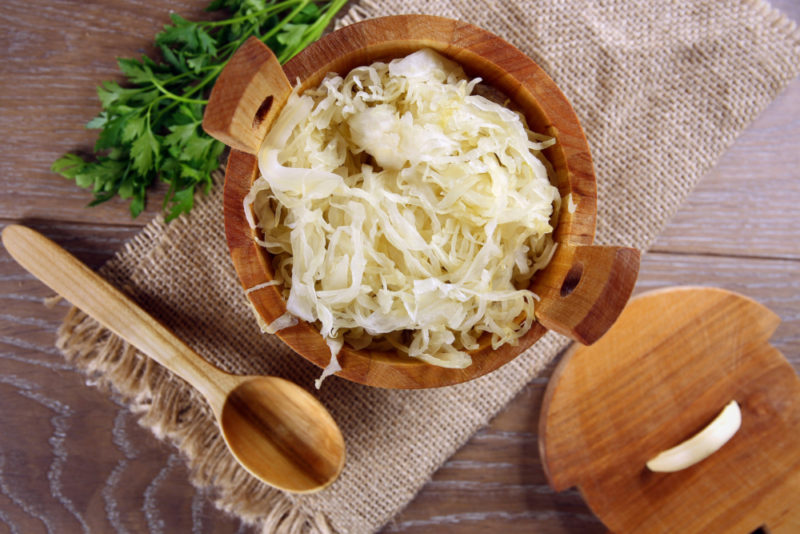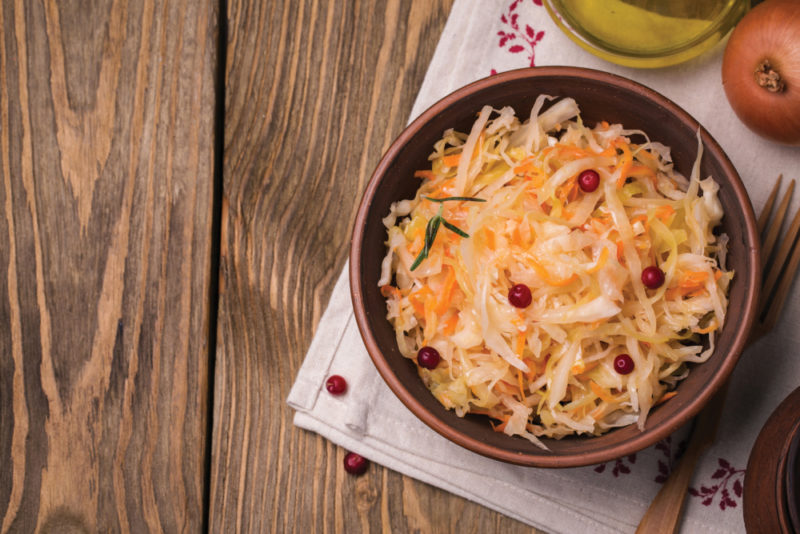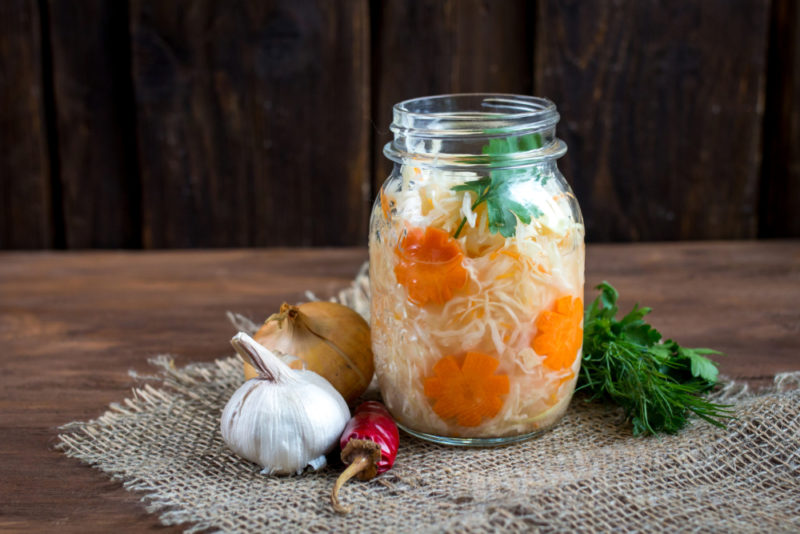Sauerkraut is considered a national dish in Chinese, German and Russian cuisines. The recipe for its preparation is not one hundred years old, but this product is still popular and loved. How many calories are in sauerkraut, what undoubted benefit does its use bring to the body - this will not only be discussed in the presented material.
Material Content:
Chemical composition and nutritional value
It is almost impossible to determine the value of a beloved dish without a preliminary analysis of the chemical composition of the product.
Consider the ratio of nutrients, calculated per 100 grams of ready-to-eat vegetable:
- water - 87.414 g;
- dietary fiber - 3.891 g;
- ash - 0.816;
- mono- and disaccharides - 4.998 g;
- starch - 0.181 g;
- polyunsaturated fatty acids - 0,092 g;
- organic acids - 1.511 g.
Eating only 100 to sauerkraut, you can get 20% of the required daily intake of fiber (dietary fiber), which will help gently cleanse the intestines of toxins and adjust its peristalsis.
How many calories in sauerkraut
Sauerkraut is an amazing product that has a negative calorie content, since the body spends much more energy on its absorption than it receives as a result of consumption. This property of a cruciferous vegetable is worth knowing to everyone who wants to "lose" weight correctly.
Since the vegetable is rarely eaten separately, and often combined with carrots, onions and vegetable oil, we will consider the calorie content and energy value of each of the possible options:
| Calories, kcal / 100 g | The energy value, % | |||
|---|---|---|---|---|
| squirrels | fats | carbohydrates | ||
| Sauerkraut | 27 | 1,6 | 0,1 | 5,2 |
| Sauerkraut with carrots | 32 | 1,3 | 0,1 | 4,63 |
| Sauerkraut with vegetable oil and onions | 61,2 | 1,6 | 4,5 | 5,3 |
| Sauerkraut with vegetable oil | 61 | 1,6 | 4,5 | 5,3 |
The content of vitamins and minerals
The low calorie content of the product contrasts with the “magnificent bouquet” of vitamins and minerals that it is rich in.
Among the first row, it should be noted that there is a lot of vitamin C in pickled vegetables, almost all elements of group B (B1, B2, B5, B6, B9). Folic acid (vitamin B9) is involved in the formation of new cells, which makes sauerkraut simply invaluable for pregnant women, especially given the ability of such cabbage to reduce the manifestations of toxicosis.
And it also contains vitamins K, PP and U. The latter is the "calling card" of pickled vegetables, as it is completely destroyed by heating.
Among the trace elements that such an appetizer contains in excess, it should be noted potassium, calcium, zinc, selenium, iron, iodine, phosphorus and sodium.
Daily rate of consumption of the product in the table
Sauerkraut is rich in vitamins and minerals that our ancestors could not get in winter except from the white component. It seems that such a useful product can be included in your diet for all, without exception, in unlimited quantities, but here you must adhere to moderation.
So, the use of acidic food, which includes cabbage, should be excluded for patients with a stomach ulcer and duodenal ulcer. Since table salt is the main preservative in the cooking process, its excess in the diet entails fluid retention and problems with the heart and blood vessels. It is not recommended to give pickled and soaked fruits and vegetables to children under 5 years old.
The use of sour cabbage twice a week, 100 g each, is considered completely harmless.
To achieve results aimed at reducing the symptoms of a disease or preventing it, the norms given in the table should be adhered to:
| Daily intake | |
|---|---|
| To ensure the full functioning of an adult, practically healthy person | 100 to 150 g daily |
| To lower blood sugar (type 2 diabetes) | 100-120 g per day |
| To reduce the risk of lung and prostate cancer | 100 g up to 3 times a week |
| During treatment of bronchial asthma | 500 g daily |
| To improve male potency | 300 g per day |
| For antiparasitic therapy | 100-200 g 2-3 g per day |
Useful properties for the body
Vitamins and microelements, which are rich in sauerkraut, determine its truly miraculous and very useful properties for the body:
- Fermentation of a fresh vegetable occurs as a result of the activity of sour milk bacteria, which, when ingested with food, normalize the flora of the entire gastrointestinal tract.
- Sauerkraut is a source of vitamin C (ascorbic acid), which supports the body's protective functions at the proper level. Only two hundred grams of crispy salad will cover half the daily allowance of this element.
- Calcium and antioxidants, which are part of the product, strengthen bones and support their growth, as well as inhibit inflammatory processes in the joints and muscles.
- Probiotics, which are abundant in pickled snacks, help lower cholesterol and normalize blood sugar, which serves as a good prevention of cardiovascular disease and diabetes.
- Glucosinatol and bacteria Lactobacillus plantarum in pickled vegetables help to restore cells and cleanse the body, which also helps in the fight against cancer in its initial stages.
- It is shown to use a crispy pickled dish as a side dish for meat, since the vitamin B6 contained in cabbage will ensure the absorption of protein, and will also positively affect the state of the nervous system, skin, hair and nails.
In conclusion, it should be noted that in order to get the maximum benefit from the product, you should not allow freezing of sauerkraut or its heating, which reduce the content or completely destroy all the vitamins in excess present in this wonderful treat.
















